
Asterivora combinatana is a species of moth in the family Choreutidae. It is endemic to New Zealand and has been observed at locations in both the North and South Islands. The larvae feed on Senecio bellidioides and Brachyglottis repanda either from within a silken gallery or alternatively a silken curtain under which they feed. It is double brooded with adults being on the wing from September until November and again from February until April. This species is a day flying moth. It is extremely variable both in colouration and in size. The female tends to be larger and paler than the male of the species.

Izatha metadelta is a moth of the family Oecophoridae. It is endemic to New Zealand, where it is known from the North Island only. It is rare north of Waikato and the Bay of Plenty.
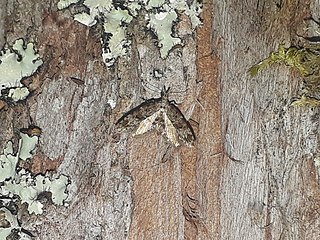
Isonomeutis restincta, the marbled snouter, is a species of moth in the family Copromorphidae. It is endemic to New Zealand where it is likely found in the northern parts of the North Island. Not much is known of the life history of this species but it has been hypothesised that it is a scale insect predator. The adults of this species are on the wing from November to January. This species has been classified as "At Risk, Naturally Uncommon" by the Department of Conservation.

Pasiphila plinthina is a moth in the family Geometridae. It is endemic to New Zealand and is found in both the North, South and Stewart Islands. It is on the wing mainly from June until September with occasional observations up to December, and is attracted to light. This species is similar in appearance to P. sandycias but can be distinguished from it as P. plinthina has palpi that are longer and has more blurred forewing markings.

Chersadaula ochrogastra is a species of moth in the family Oecophoridae. This species is endemic to New Zealand. It is classified as "Data Deficient" by the Department of Conservation.

Pyrgotis eudorana is a species of moth of the family Tortricidae. It is endemic in New Zealand and has been observed in both the North and South Islands. However it is regarded as a rare insect. This species inhabits native forest. Larvae exclusively feed on Muehlenbeckia australis and adults are on the wing from November to April. Adults are attracted to light.

Pyrgotis plinthoglypta is a species of moth of the family Tortricidae. It is endemic to New Zealand and is found throughout the whole country. The preferred habitat of this species is native forest. The larvae of this species feeds on rimu leaves from under a silken web. It pupates in loose cocoons amongst rimu foliage. Adults are on the wing from October to May and are night flying. They are attracted to light and can be collected by beating their host tree. The adult insect resembles a small dried fragment of rimu foliage when at rest.
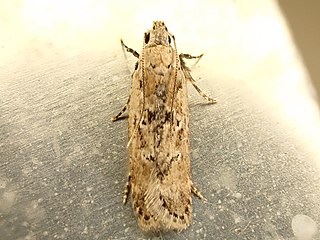
Anisoplaca achyrota is a species of moth in the family Gelechiidae. It was first described by Edward Meyrick in 1885 and is endemic to New Zealand. This species has been observed in both the North and South Islands and inhabits native forest. The larvae of this species feed on the green seeds of Hoheria angustifolia and as such is regarded as an indicator species for mature native forest. The adults of the species are commonly on the wing from December until February and are attracted to light.

Proteodes melographa is a species of moth in the family Depressariidae. It is endemic to New Zealand and has been observed at Mount Arthur and in the Nelson District. It inhabits forest in the alpine zone. The larvae of this species feeds on native beech trees.
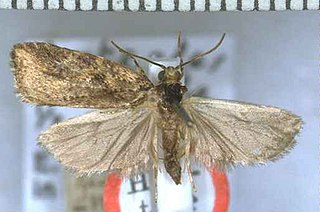
Proteodes profunda is a species of moth in the family Depressariidae. It is endemic to New Zealand. This species has been collected in its type locality of Mount Holdsworth in the Tararua Range, Raurimu near Tongariru National Park, Days Bay in Wellington, Mount Arthur, Otira, Invercargill, and in Southland. P. profunda lives in beech forests at altitudes of around 2000 ft and larvae feed on beech tree leaves. Adults of this species are on the wing from November to February.

Tingena chloradelpha is a species of moth in the family Oecophoridae. It is endemic to New Zealand and can be found in the North and South Islands. The larvae live underground forming silken tubes from which it feeds. It overwinters in these tubes and then pupates enclosed in a weak pale white silken cocoon. The adults of this species is variable in appearance both in the depth of colour as well as in its discal spots which may in some specimens be lacking. The adults are on the wing from October until the end of December and can be found inhabiting domestic gardens as well as cultivated land. They have been seen resting on window frames and can be found inside houses.

Tingena eumenopa is a species of moth in the family Oecophoridae. It is endemic to New Zealand and found in the North and South Islands. The adults have been found amongst tree ferns and are on the wing in December.

Tingena oxyina is a species of moth in the family Oecophoridae. It is endemic to New Zealand and has been observed in the Otago region. This species inhabits native beech forest at altitudes of between 1000 - 3000 ft. Adults of this species are on the wing in January.
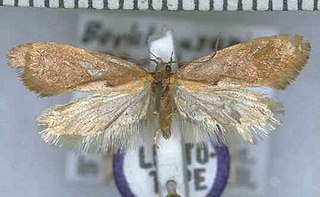
Tingena perichlora is a species of moth in the family Oecophoridae. It is endemic to New Zealand and has been observed in the southern parts of the South Island. This species appears to inhabit manuka scrub. Adults of this species are on the wing from October to January.
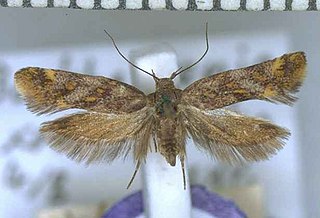
Tingena xanthomicta is a species of moth in the family Oecophoridae. It is endemic to New Zealand and has been found in both the North and South Islands. This species inhabits native scrub on hillsides and appears to be attracted to Coprosma areolata. Adults are on the wing from November until February.

Asaphodes nephelias is a moth in the family Geometridae. It is endemic to New Zealand and has been observed in the South Island. The preferred habitat of this species is alpine tussock grasslands above native forest and in wetlands. The adults of this species are on the wing from January to March and are day flying. The female has brachypterous wings.

Trachypepla galaxias is a moth of the family Oecophoridae first described by Edward Meyrick in 1883. It is endemic to New Zealand and can be found throughout the country. This species inhabits native forest. The life history of this species is currently unknown. Adults are on the wing from October to February, are nocturnal and are attracted to light.

Trachypepla leucoplanetis is a moth of the family Oecophoridae first described by Edward Meyrick in 1883. It is endemic to New Zealand and has been collected in both the North and South Islands. It is the smallest moth species in the genus Trachypepla and the patterns on the forewings of adults are variable in appearance. It inhabits native forest and bush and the larvae feed on leaf litter. Adults are on the wing from October until February. T. leucoplanetis is regarded as being rarely observed and has been collected via the beating of foliage.

Trachypepla lichenodes is a moth of the family Oecophoridae first described by Edward Meyrick in 1883. It is endemic to New Zealand and has been found in both the North and South Islands. It inhabits native forest and adults of this species are on the wing from November to January. The adult moths are similarly coloured to native lichen species however this colouration is variable in the extent and depth on the forewings.

Trachypepla spartodeta is a moth of the family Oecophoridae first described by Edward Meyrick in 1883. It is endemic to New Zealand and has been collected in both the North and South Islands. This species inhabits native forest and adults are on the wing from November to January.























